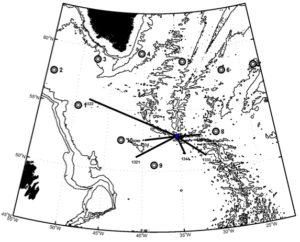OSNAP, Year 3 Leg 1, 57 55.86N 25 6.19W, 09-July-2016, Weather day.
By Heather Furey
Yesterday, the sea was molten silver. No organized swell, just a satin finish top, with the water  moving underneath as though thickly boiling, heaving. I like to go to sea for the work of it, and because I have a great job. But the human details are what I enjoy most while out here.
moving underneath as though thickly boiling, heaving. I like to go to sea for the work of it, and because I have a great job. But the human details are what I enjoy most while out here.
Because this is an international program, each year, and sometimes each leg, the research program utilizes ships from different countries. People from everywhere staff the ships and ride as science crew. The most important thing for me is to try to pick apart dialects and accents. We need to understand each other to successfully get our work done. I find particular delight in the French accent, perhaps because I studied French in school for four years. On board this year, I am trying to understand thick Scottish-, British-, and Chinese-accented English. And French. I miss our Dutch colleagues. The Dutch nationals will all be on the next leg, boarding in Reykjavik for Leg 2 OSNAP, to ride the RRS Discovery’s return trip from Reykjavik to Southampton.
I notice, too, the way different groups hold cutlery. Americans do not generally hold their knives while eating. They move the knife to the fork hand to cut, then cut, then put the knife back down, move the fork back to the hand that just held the knife, and pick up the bite with their fork. Scottish and British tend to hold on to both pieces of silverware all the time. They push food onto their forks using their knives, and then lift the fork up to eat. No transfer of knife to the other hand if cutting is required. English in particular tends to eat with their fork upside-down, along with the knife in the opposite hand.

 Condiments on each ship are a playground. ‘Heinz Salad Cream’? ‘HP Sauce’? ‘Golden Shredless’? ‘Robinson’s Barley Water’? ‘HP Fruity’? What are these? ‘Bovril: The Original Beef Extract’? Am I supposed to put that on toast? It is stored in with the peanut butter, jams, and butter pats. Why would I put beef extract on my toast?
Condiments on each ship are a playground. ‘Heinz Salad Cream’? ‘HP Sauce’? ‘Golden Shredless’? ‘Robinson’s Barley Water’? ‘HP Fruity’? What are these? ‘Bovril: The Original Beef Extract’? Am I supposed to put that on toast? It is stored in with the peanut butter, jams, and butter pats. Why would I put beef extract on my toast?
Back to science and hot off the press, the very first batch of RAFOS floats, deployed in June 2014 off the R/V Knorr, has surfaced! With this type of instrument, it is all about where the water goes, and not about how the water changes while moving past a stationary point (e.g., mooring).
 Usually the sample size is small, but, always, something new is learned. So where did the floats that seeded the Iceland-Scotland Overflow Water in the deep Charlie-Gibbs Fracture Zone go over the past two years? I have not had time to work up the trajectory data, but can show you the two-year displacement vector diagram I worked up this morning. Deployment site is at the blue dot in the Charlie-Gibbs; black lines show the 2-year displacement; bullets denote sound source locations, bathymetry drawn at 1000, 2000, and 3000 meters. The floats launched in the deepest currents off the East Reykjanes Ridge and off East Greenland in summer 2014 will surface late July and Mid-August, respectively. The RAFOS results are starting to come in. Stay tuned.
Usually the sample size is small, but, always, something new is learned. So where did the floats that seeded the Iceland-Scotland Overflow Water in the deep Charlie-Gibbs Fracture Zone go over the past two years? I have not had time to work up the trajectory data, but can show you the two-year displacement vector diagram I worked up this morning. Deployment site is at the blue dot in the Charlie-Gibbs; black lines show the 2-year displacement; bullets denote sound source locations, bathymetry drawn at 1000, 2000, and 3000 meters. The floats launched in the deepest currents off the East Reykjanes Ridge and off East Greenland in summer 2014 will surface late July and Mid-August, respectively. The RAFOS results are starting to come in. Stay tuned.